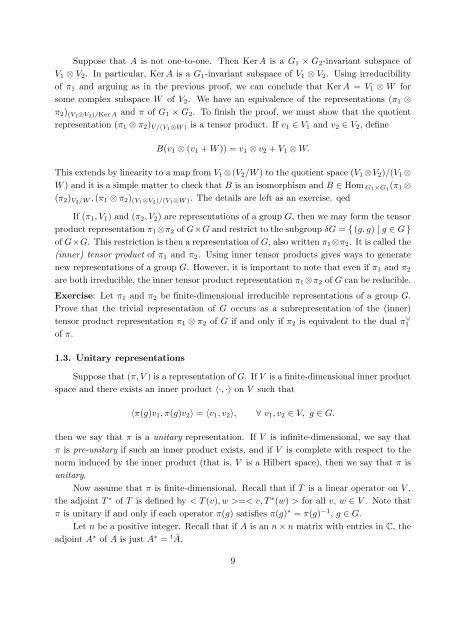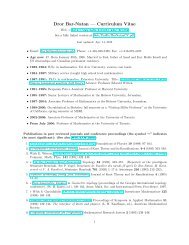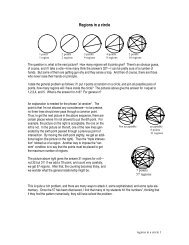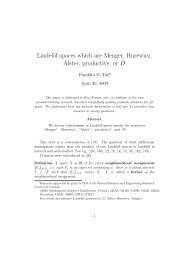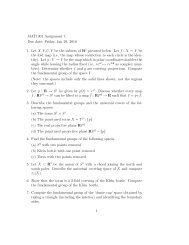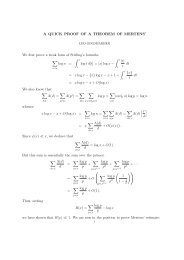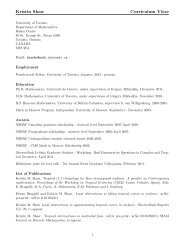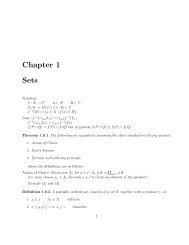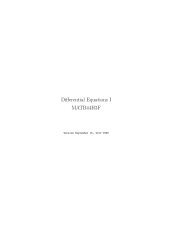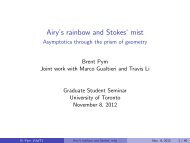MAT 445/1196 - INTRODUCTION TO REPRESENTATION THEORY ...
MAT 445/1196 - INTRODUCTION TO REPRESENTATION THEORY ...
MAT 445/1196 - INTRODUCTION TO REPRESENTATION THEORY ...
You also want an ePaper? Increase the reach of your titles
YUMPU automatically turns print PDFs into web optimized ePapers that Google loves.
Suppose that A is not one-to-one. Then Ker A is a G1 × G2-invariant subspace of<br />
V1 ⊗ V2. In particular, Ker A is a G1-invariant subspace of V1 ⊗ V2. Using irreducibility<br />
of π1 and arguing as in the previous proof, we can conclude that Ker A = V1 ⊗ W for<br />
some complex subspace W of V2. We have an equivalence of the representations (π1 ⊗<br />
π2) (V1⊗V2)/Ker A and π of G1 × G2. To finish the proof, we must show that the quotient<br />
representation (π1 ⊗ π2) V/(V1⊗W ) is a tensor product. If v1 ∈ V1 and v2 ∈ V2, define<br />
B(v1 ⊗ (v1 + W )) = v1 ⊗ v2 + V1 ⊗ W.<br />
This extends by linearity to a map from V1 ⊗(V2/W ) to the quotient space (V1 ⊗V2)/(V1 ⊗<br />
W ) and it is a simple matter to check that B is an isomorphism and B ∈ Hom G1×G1 (π1 ⊗<br />
(π2) V2/W , (π1 ⊗ π2) (V1⊗V2)/(V1⊗W ). The details are left as an exercise. qed<br />
If (π1, V1) and (π2, V2) are representations of a group G, then we may form the tensor<br />
product representation π1 ⊗π2 of G×G and restrict to the subgroup δG = { (g, g) | g ∈ G }<br />
of G×G. This restriction is then a representation of G, also written π1 ⊗π2. It is called the<br />
(inner) tensor product of π1 and π2. Using inner tensor products gives ways to generate<br />
new representations of a group G. However, it is important to note that even if π1 and π2<br />
are both irreducible, the inner tensor product representation π1 ⊗π2 of G can be reducible.<br />
Exercise: Let π1 and π2 be finite-dimensional irreducible representations of a group G.<br />
Prove that the trivial representation of G occurs as a subrepresentation of the (inner)<br />
tensor product representation π1 ⊗ π2 of G if and only if π2 is equivalent to the dual π ∨ 1<br />
of π.<br />
1.3. Unitary representations<br />
Suppose that (π, V ) is a representation of G. If V is a finite-dimensional inner product<br />
space and there exists an inner product 〈·, ·〉 on V such that<br />
〈π(g)v1, π(g)v2〉 = 〈v1, v2〉, ∀ v1, v2 ∈ V, g ∈ G.<br />
then we say that π is a unitary representation. If V is infinite-dimensional, we say that<br />
π is pre-unitary if such an inner product exists, and if V is complete with respect to the<br />
norm induced by the inner product (that is, V is a Hilbert space), then we say that π is<br />
unitary.<br />
Now assume that π is finite-dimensional. Recall that if T is a linear operator on V ,<br />
the adjoint T ∗ of T is defined by < T (v), w >=< v, T ∗ (w) > for all v, w ∈ V . Note that<br />
π is unitary if and only if each operator π(g) satisfies π(g) ∗ = π(g) −1 , g ∈ G.<br />
Let n be a positive integer. Recall that if A is an n × n matrix with entries in C, the<br />
adjoint A ∗ of A is just A ∗ = t Ā.<br />
9


